How To Use A Mouth Harp
This postal service contains chapter links. Nosotros earn commissions if you purchase products from retailers after clicking on a link from our site. Every bit an Amazon Associate, we earn from qualifying purchases.
If you just bought a jaw harp and you whacked yourself in the teeth--you're in the right place! I've done that many a time and over time I've learned the proper technique to forestall teeth damage from the jaw harp.
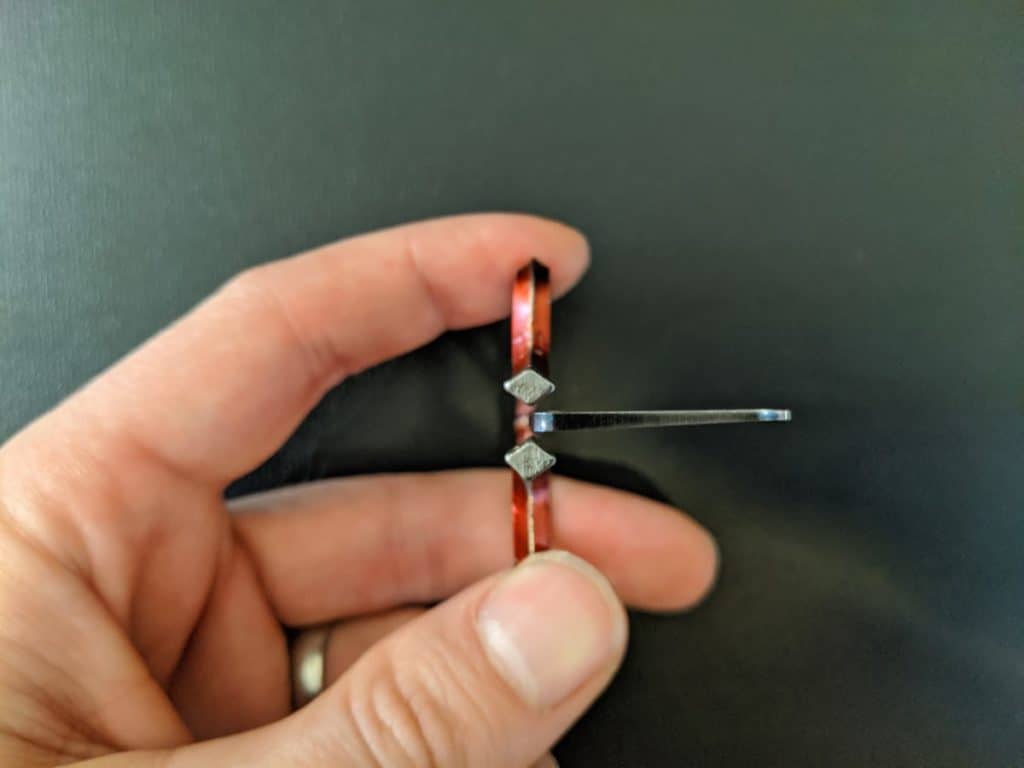
By the manner, looking for recording equipment? Check out MusiciansFriend.com for microphones, monitors, audio interface or any other recording gear that you lot could ever need. (Affiliate Link)
Teeth impairment from the jaw harp is caused generally from improper technique, including teeth position, reed playing bending, improper pressure level, and overly rough playing. In combination with jaw harps with stiffer reeds, these factors can lead to teeth impairment.
Never fearfulness! The proper technique is not too complicated, it just takes a little bit of cognition and yous'll know how to play without hurting your precious teeth.
If you want to watch this information in video form, check out my video here:
Can Jaw Harps Impairment Your Teeth?
Crucial Techniques for Playing the Jaw Harp Without Damaging Your Teeth
There are many factors that can lead to cleaved teeth--which is non fun! So it's really worth spending the time to know how to play the jaw harp then you lot can enjoy the musical instrument without chipping a molar.
Before we become started, though, it's super worth it to sympathize the different parts of a jaw harp and then you can know the terminology I'm going to utilize.
Jaw Harp Beefcake and Basics
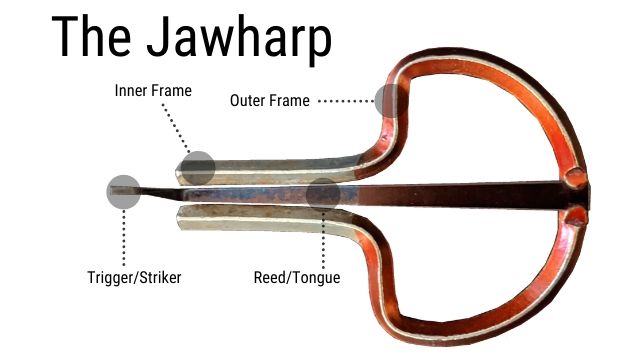
The inner frame is where you will exist placing role of the jaw harp in your mouth so information technology needs to be clear, and then to exercise that, you hold the jaw harp by the outer frame without touching the reed (the centre piece of flexible metal that'south crimped onto the frame.
To play the jaw harp, you lot hold the jaw harp confronting your teeth, with the trigger pointing away from your face. You so use your lips to cover some of the inner frame, and and so pull the trigger back (very gently) and release.
Teeth Placement: Jaw Harps Don't Seize with teeth, So You Shouldn't Seize with teeth Them
By far, the biggest mistake people when playing the jaw harp that is very unsafe is to seize with teeth the jaw harp.
It's an easy mistake to make. If yous've never played earlier, you've probably seen people play and it looks like they are biting the jaw harp. This is non the instance--biting the jaw harp can cause damage to your teeth and to your lips. The jaw harp vibrates significantly when played and this kind of rattling is liable to chip something.
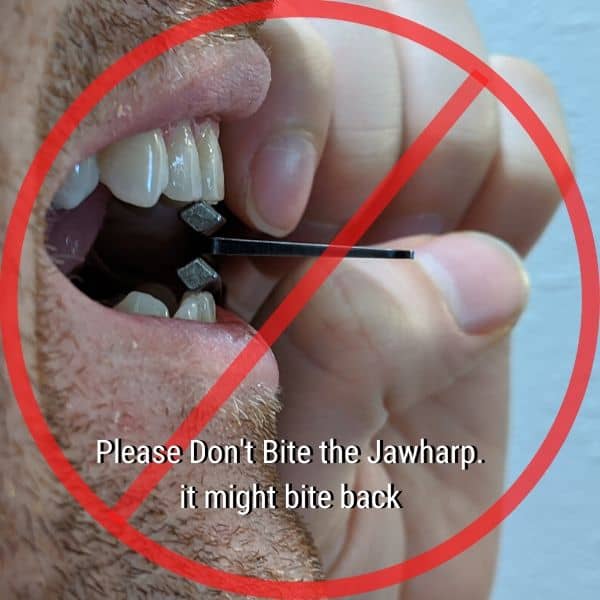
And then… how are you supposed to play?
Instead of putting the inner frame between your teeth, place the jaw harp firmly against the forepart of your teeth, similar so:
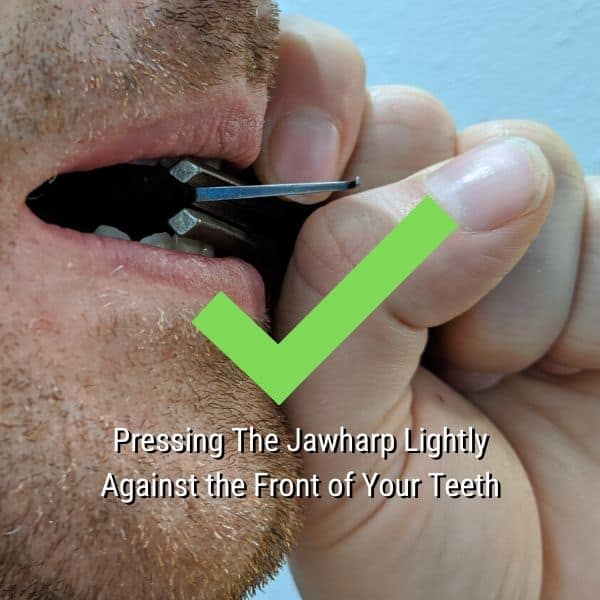
This is not exactly the right mouth shape, I accept my mouth slightly open up so you can run across how the jawharp is against my teeth instead of between them. Nonetheless, this also shows that there needs to be a gap between your teeth so that the reed can pass through freely.
An instance of how it would look if you have the jaw harp correctly confronting your teeth with your lips over the inner frame:
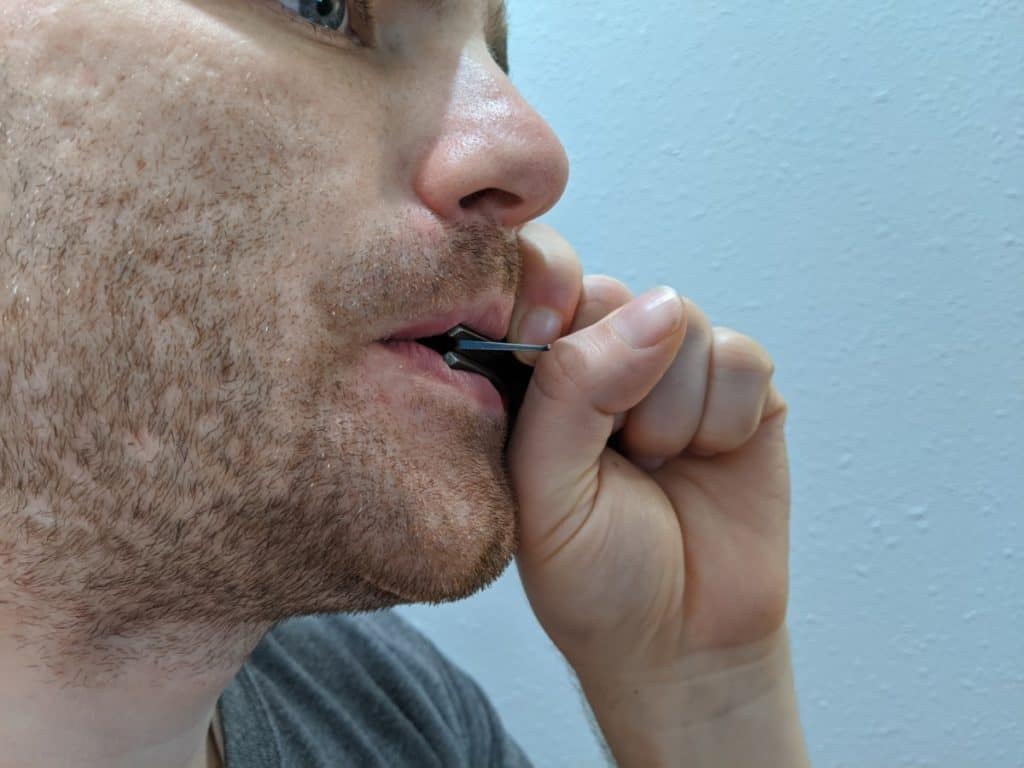
Notice how my my lips are creating a seal over the inner frame. Y'all can't run across it, only the jaw harp is beingness pressed confronting the forepart of my teeth.
Besides very important: you must keep a gap between your teeth. My teeth are slightly open and so the reed has space to motion betwixt them. If this gap is too small, then when I press the trigger of the harp the reed volition come back and whack me in the teeth.
Summary: The near important matter y'all tin do to protect your teeth and your lips while playing the jaw harp is to not bite the jaw harp.
Playing Angle: No Tilt
A tricky thing to get used to is that the reed is a flexible piece of metallic that is pressed by the trigger or striker, which needs to be pressed pressed in only ane direction. That is, straight towards your face.
If you strike the trigger at an angle, the reed will respond at that opposite angle, which unfortunately means that information technology's going to hit your teeth or your lips. Pull the striker (gently) exactly away from you as you're playing without any tilt and you'll brand sure the reed goes merely straight back.
Movie the Striker Towards Your Mouth
It's a little tempting to push the striker abroad from you lot, but the trouble is that it causes a lot of tension that volition whip back towards you. This is much more than dangerous to your teeth. Information technology's definitely possible to play both directions but in general endeavor and make it a addiction to film the striker towards your face.
Playing Gently: Don't Play Pinball With Your Jaw Harp
Did you lot ever play with one of those old pinball machines? The mode you launched the metallic ball into the game was to pull back a knob that was attached to a spring.
Because we are human beings, we naturally will pull that spring dorsum as far as possible to let that metallic brawl fly!
This exact same tendency happens with the jaw harp. Maybe we're jammin' out and feeling the music--it'south a tendency to desire to pull back the striker as far as possible to try and get more volume.
Resist that inner ten-yr old inside you. Rather, pull back the trigger gently and and then let it go. Information technology takes some practice to get the hang of the instrument, and then practice very gently before trying to increment your volume.
Beware the Catching Ball Trigger
The jaw harp pictures you meet above are examples of a jaw harp that does non have a ball trigger. Some jaw harps have the metal coiled up at the stop of the trigger. If I had to guess why, I'd say this ball trigger is in that location to make it easier to push the trigger, or mayhap make information technology more comfortable than pulling your finger off a thin piece of metal for an extended period of fourth dimension.
Why beware the ball trigger? The reason why is that the ball (which is usually going to just exist the metal coiled up) has an edge at the base of the brawl. If you accidentally catch this border, then you are going to push back the trigger far more than you lot intended.
This could merely make a louder twang, or, information technology could lift the unabridged jaw harp away from your face up. At this point, when you release the trigger, the unabridged jaw harp is going to hurtle towards your teeth.
You tin can remove the brawl and but file downwardly the end of the metal to remove any abrupt edges, with a slight bend away from you to brand information technology more comfortable, or you can use some extra intendance with jaw harps that have a ball trigger.
Finding the Exact Pressure Residual To Relieve Your Teeth
What'southward tricky almost the jaw harp is that yous are using your oral cavity cavity to resonate the jaw harp, and therefore the jaw harp is being balanced with your skull (essentially), with your teeth as the meeting signal.
There's no getting around it, the jaw harp is going to be in direct contact with your teeth--but proper technique can make this safer.
While playing, you need to have the jaw harp pressed against your teeth firmly.
If y'all don't accept the jaw harp placed firmly enough, and so the jaw harp is going to rattle against your teeth, which is not good for your teeth and non good for your sound.
If you lot accept besides much pressure against your teeth then you might experience a jaw ache or a headache.
The goal is to put as fiddling pressure as yous can, while all the same holding plenty force per unit area to keep the jaw harp firmly against your teeth without any rattling.
The Dangers of a Stiff Reed
As I was researching this topic, i thing I learned is that a stiff reed tin can really lead to jaw aches! Since you lot are pressing the jaw harp against your teeth, if the momentum is strong enough such as with a thick, dense, and strong reed, then your skull and jaw are going to rattle more.
I recommend using a jaw harp that has a more flexible reed then you tin can avoid this issue.
Don't Close the Gap
One super fascinating tendency when you're trying to increase the volume is to actually try and shut your lips effectually the entire inner frame to increase your resonance . This can actually lead to scrapping the inside of your lip. Check out this video for an excellent clarification how to avoid this:
What to practise almost a Bloody Jaw Harp?
Alternatives to Playing With Your Teeth: Lip Harps
There's some other instrument called the dan moi. This instrument is actually designed to be played with your lips enclosing it without putting it against your teeth. This has a similar (just different) sound, but can be used as an alternative to a traditional jaw harp that you play against your teeth.
Run into hither for an instance (Amazon)
Beginner Jaw Harps That Won't Destroy Your Teeth
1 affair I'll mention before closing upwardly this post: The most common jaw harp that people know of is Snoopy's Jaw Harp. It's perhaps one of the cheapest you can find, which makes sense--but this item jaw harp has a very strong reed.
I'd recommend not trying to learn the jaw harp on the Snoopy, considering it has such a thick reed, and you're but getting used to playing--when you mess upward and slip, that huge thick reed is going to smack you in the teeth--which is really, really painful.
If you're looking for something super cheap, and then I'd recommend the Grover, or if you'd like something a pace upwardly from that, there is the Potkin. (both on Amazon)
How To Use A Mouth Harp,
Source: https://soundadventurer.com/how-to-avoid-damaging-your-teeth-while-playing-the-jaw-harp/
Posted by: aldereteyetwall.blogspot.com


0 Response to "How To Use A Mouth Harp"
Post a Comment